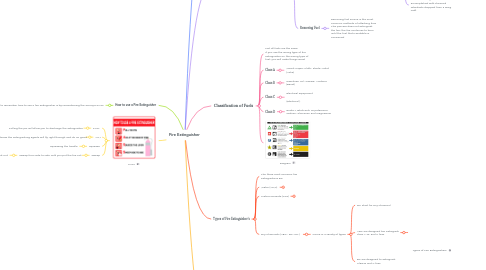
1. How to use a Fire Extinguisher
1.1. A easy way to remember how to use a fire extinguisher is by remembering the acronym PASS
2. PASS
2.1. PULL
2.1.1. Pulling the pin will allow you to discharge the extinguisher
2.2. AIM
2.2.1. Aiming at the base of the fire. If you aim at the flames the extinguishing agents will fly right through and do no good
2.3. Squeeze
2.3.1. Squeezing the handle
2.4. Sweep
2.4.1. Sweep from side to side until you put the fire out
2.4.1.1. Use the fire extinguisher from a safe distances, then slowly move forward. Keep at eye on the area once the fire is put out.
3. The Fire Triangle
3.1. To understand how fire extinguisher work, here's the first thing you need to know about fire.
3.1.1. Fire Triangle
3.1.1.1. Oxygen, heat , and fuel are frequently referred to as the " Fire Triangle" Add in a fourth element, the Chemical reaction. and you have a fire "Tetrahedron"
3.1.1.2. Fire extinguishers put out the fire by taking away one element of the fire triangle
3.2. The four things that must be presented in order to produce a fire
3.2.1. Enough oxygen to sustain combustion Enough heat to raise the material to its ignition temparute Some sort of fuel/ Combustible material Chemical, exothermic reaction that is fire.
4. Fire Safety
4.1. Based on the principle of keeping fuel sources and ignition sources separate
4.2. Breaking the Fire Triangle
4.2.1. Reducing Heat
4.2.1.1. Reducing heat on wildfires can be accomplished in two ways: Cooling with water, foam, dirt or scattering available fuels to reduce the effect of radiant heat
4.2.1.1.1. Water and dirt should be dirrectly apllied on the fuels being consumed to reduce fuel temperatures
4.2.2. Reducing Oxygen
4.2.2.1. Water, dirt, foam and retardants will reduce the supply of oxygen for the combustion process
4.2.2.1.1. Examples
4.2.3. Removing Fuel
4.2.3.1. Removing fuel source is the most common methods of attacking fires This process does not extinguish the fire, the fire continues to burn until the fuel that's available is consumed
5. Classification of Fuels
5.1. Not all fuels are the same If you use the wrong type of fire extinguisher on the wrong type of fuel, you will make things worst
5.2. Class A
5.2.1. Wood, Paper, Cloth, Plastic, Solid (Ashe)
5.3. Class B
5.3.1. Gasolines, Oil, Grease, Acetone (Barrel)
5.4. Class C
5.4.1. Electrical equipment (Electrical )
5.5. Class D
5.5.1. Exotic Metals such as potassium, sodium, aluminum and magnesium
5.6. Diagram
6. Types of Fire Extinguisher's
6.1. The three most common fire extinguishers are
6.2. Water (APW)
6.2.1. APW stands for Air Pressurized Water
6.2.1.1. They are desinged for Class A fires only ( Wood, Paper, cloth)
6.2.1.1.1. APW
6.3. Carbon Dioxide (Co2)
6.3.1. are filled with non-flammable carbon dioxide gas under extreme pressure
6.3.1.1. They are ineffective at extinguishing Class A fires due to them not being able to displace enough oxygen to put out the fire
6.3.1.1.1. Co2 are frequently found in laboratories, mechanical rooms, kitchens, and flammable liquid storages areas
6.4. Dry Chemicals (ABC , BC, DC )
6.4.1. Come in a variety of types
6.4.1.1. DC short for Dry Chemical
6.4.1.2. ABC are designed too extinguish class A, B, and C fires
6.4.1.2.1. Types of Fire Extinguishers
6.4.1.3. BC are desgined to extinguish Class B and C fires
7. Rules for fighting Fires
7.1. Activate the buildings fire alarm system or notify the fire department
7.1.1. Only after doing these two things, if the fire is small attempt to use an extinguisher to put it out
7.1.2. However before deciding to fight the fire keep these rules in mind
7.1.3. Never fight a fire if
7.1.3.1. You don't know what's burning
7.1.3.2. If you don't know what's burning you don't know which type of fire extinguisher to use
7.1.3.3. If the fire is spreading rapidly beyond the spot where it started
7.1.3.3.1. If the fire is spreading quickly, it's best to evacuate the building, closing doors and windows behind you as you leave
7.1.3.4. DO NOT FIGHT THE FIRE IF
7.1.3.4.1. You don't have appropriate equipment
7.1.3.5. You may inhale toxic smoke
7.1.3.5.1. Any sort of combustion will produce some amount of carbon monoxide
7.1.3.6. Your instincts tell you not to
7.1.3.6.1. Trust your gut, if you are uncomfortable with the situation, let the fire department do their job
7.1.3.7. The final rule
7.1.3.7.1. Always position yourself with an exit or means of escape at your back before you attempt to use an extinguisher to put out a fire
